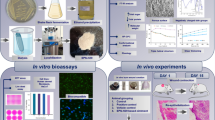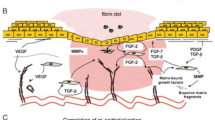Abstract
Gingival wound healing plays a critical role in maintaining oral health. However, this process can be delayed by oxidative stress and excessive inflammatory responses. In this study, we established a human inflammatory gingival tissue equivalent (iGTE) to investigate the inhibitory effects of hydrogen-rich water (HW), enzyme-digested edible bird’s nest (EBND) and sialic acid (SA) on PMA (an inducer of oxidative free radicals)- and LPS (an inflammatory stimulus)-impaired wound healing. The iGTE was constructed by human gingival fibroblasts (hGFs), keratinocytes and macrophages under three-dimensional conditions. Wounds in the iGTE and hGF/keratinocyte monolayers were created by mechanical injury. Tissues and cells were pretreated with HW, EBND, and SA, and then exposed to the inflammatory and oxidative environment induced by PMA (10 ng/mL) and LPS (250 ng/mL). The inflammatory cytokines IL-6 and IL-8 were quantitatively analyzed by ELISA. Histopathological image analysis was performed by HE and immunofluorescence staining. In the iGTE, PMA/LPS significantly reduced the epithelial thickness while causing a decrease in K8/18, E-cadherin, laminin and elastin expression and an increase in COX-2 expression along with ulcer-like lesions. In mechanically scratched hGFs and keratinocyte monolayers, PMA/LPS significantly impaired wound healing, and promoted the secretion of IL-6 and IL-8. Pretreatment of HW, EBND, and SA significantly suppressed PMA/LPS-induced wound healing delay and inflammatory responses in cell monolayers, as well as in the iGTE. Remarkably, the combined use of HW and EBND exhibited particularly robust results. Combined use of HW and EBND may be applied for the prevention and treatment of wound healing delay.





Similar content being viewed by others
Data availability
The data presented in this study are available within the article. Other data related to this study are available on request from the corresponding author.
References
Smith PC, Cáceres M, Martínez C, Oyarzún A. Martínez J. Gingival wound healing: an essential response disturbed by aging? J Dent Res. 2015;94:395–402. https://doi.org/10.1177/0022034514563750.
Ahangar P, Mills SJ, Smith LE, Gronthos S, Cowin AJ. Human gingival fibroblast secretome accelerates wound healing through anti-inflammatory and pro-angiogenic mechanisms. NPJ Regen Med. 2020;5:24. https://doi.org/10.1038/s41536-020-00109-9.
Krzyszczyk P, Schloss R, Palmer A, Berthiaume F. The role of macrophages in acute and chronic wound healing and interventions to promote pro-wound healing phenotypes. Front Physiol. 2018;9:419. https://doi.org/10.3389/fphys.2018.00419.
Larouche J, Sheoran S, Maruyama K, Martino MM. Immune regulation of skin wound healing: mechanisms and novel therapeutic targets. Adv Wound Care (New Rochelle). 2018;7:209–31. https://doi.org/10.1089/wound.2017.0761.
Guo S, Dipietro LA. Factors affecting wound healing. J Dent Res. 2010;89:219–29. https://doi.org/10.1177/0022034509359125.
Edwards R, Harding KG. Bacteria and wound healing. Curr Opin Infect Dis. 2004;17:91–6. https://doi.org/10.1097/00001432-200404000-00004.
Dunnill C, Patton T, Brennan J, et al. Reactive oxygen species (ROS) and wound healing: the functional role of ROS and emerging ROS-modulating technologies for augmentation of the healing process. Int Wound J. 2017;14:89–96. https://doi.org/10.1111/iwj.12557.
Crompton R, Williams H, Ansell D, et al. Oestrogen promotes healing in a bacterial LPS model of delayed cutaneous wound repair. Lab Invest. 2016;96:439–49. https://doi.org/10.1038/labinvest.2015.160.
Wang G, Yang F, Zhou W, Xiao N, Luo M, Tang Z. The initiation of oxidative stress and therapeutic strategies in wound healing. Biomed Pharmacother. 2023;157: 114004. https://doi.org/10.1016/j.biopha.2022.114004.
Cho YD, Kim KH, Lee YM, Ku Y, Seol YJ. Periodontal wound healing and tissue regeneration: a narrative review. Pharmaceuticals (Basel). 2021;14:456. https://doi.org/10.3390/ph14050456.
Sim M, Kim CS, Shon WJ, Lee YK, Choi EY, Shin DM. Hydrogen-rich water reduces inflammatory responses and prevents apoptosis of peripheral blood cells in healthy adults: a randomized, double-blind, controlled trial. Sci Rep. 2020;10:12130. https://doi.org/10.1038/s41598-020-68930-2.
Mikami T, Tano K, Lee H, et al. Drinking hydrogen water enhances endurance and relieves psychometric fatigue: a randomized, double-blind, placebo-controlled study 1. Can J Physiol Pharmacol. 2019;97:857–62. https://doi.org/10.1139/cjpp-2019-0059.
Gu Y, Huang CS, Inoue T, et al. Drinking hydrogen water ameliorated cognitive impairment in senescence-accelerated mice. J Clin Biochem Nutr. 2010;46:269–76. https://doi.org/10.3164/jcbn.10-19.
Xiao L, Miwa N. Hydrogen-rich water achieves cytoprotection from oxidative stress injury in human gingival fibroblasts in culture or 3D-tissue equivalents, and wound-healing promotion, together with ROS-scavenging and relief from glutathione diminishment. Hum Cell. 2017;30:72–87. https://doi.org/10.1007/s13577-016-0150-x.
Kucerova R, Ou J, Lawson D, Leiper LJ, Collinson JM. Cell surface glycoconjugate abnormalities and corneal epithelial wound healing in the pax6+/− mouse model of aniridia-related keratopathy. Invest Ophthalmol Vis Sci. 2006;47:5276–82. https://doi.org/10.1167/iovs.06-0581.
Ghatak S, Maytin EV, Mack JA, et al. Roles of proteoglycans and glycosaminoglycans in wound healing and fibrosis. Int J Cell Biol. 2015;2015: 834893. https://doi.org/10.1155/2015/834893.
Yida Z, Imam MU, Ismail M, et al. Edible Bird’s Nest attenuates high fat diet-induced oxidative stress and inflammation via regulation of hepatic antioxidant and inflammatory genes. BMC Complement Altern Med. 2015;15:310. https://doi.org/10.1186/s12906-015-0843-9.
Hu Q, Li G, Yao H, et al. Edible bird’s nest enhances antioxidant capacity and increases lifespan in Drosophila Melanogaster. Cell Mol Biol (Noisy-le-Grand). 2016;62:116–122.
Vimala B, Hussain H, Wan Nazaimoon WM. Effects of edible bird’s nest on tumour necrosis factor-α secretion, nitric oxide production and cell viability of lipopolysaccharide-stimulated RAW 264.7 macrophages. Food Agric Immunol. 2012;23:303–314. https://doi.org/10.1080/09540105.2011.625494.
Chua KH, Mohamed IN, Mohd Yunus MH, et al. The anti-viral and anti-inflammatory properties of edible bird’s nest in influenza and coronavirus infections: from pre-clinical to potential clinical application. Front Pharmacol. 2021;12: 633292. https://doi.org/10.3389/fphar.2021.633292.
Wang D, Shimamura N, Mochizuki M, Nakahara T, Sunada K, Xiao L. Enzyme-digested edible bird’s nest (EBND) prevents UV and arid environment-induced cellular oxidative stress, cell death and DNA damage in human skin keratinocytes and three-dimensional epithelium equivalents. Antioxidants (Basel). 2023;12:609. https://doi.org/10.3390/antiox12030609.
Xiao L, Miwa N. Hydrogen nano-bubble water suppresses ROS generation, adipogenesis, and interleukin-6 secretion in hydrogen-peroxide- or PMA-stimulated adipocytes and three-dimensional subcutaneous adipose equivalents. Cells. 2021;10:626. https://doi.org/10.3390/cells10030626.
Boukamp P, Petrussevska RT, Breitkreutz D, Hornung J, Markham A, Fusenig NE. Normal keratinization in a spontaneously immortalized aneuploid human keratinocyte cell line. J Cell Biol. 1988;106:761–71. https://doi.org/10.1083/jcb.106.3.761.
Xiao L, Mochizuki M, Nakahara T, Miwa N. Hydrogen-generating silica material prevents UVA-ray-induced cellular oxidative stress, cell death, collagen loss and melanogenesis in human cells and 3D skin equivalents. Antioxidants (Basel). 2021;10:76. https://doi.org/10.3390/antiox10010076.
Xiao L, Okamura H, Kumazawa Y. Three-dimensional inflammatory human tissue equivalents of gingiva. J Vis Exp. 2018; 57157. https://doi.org/10.3791/57157
Xiao L, Mochizuki M, Wang D, Shimamura N, Sunada K, Nakahara T. Types of cell culture inserts affect cell crosstalk between co-cultured macrophages and adipocytes. Biochem Biophys Res Commun. 2023;658:10–7. https://doi.org/10.1016/j.bbrc.2023.03.068.
Burgess A, Vigneron S, Brioudes E, Labbé JC, Lorca T, Castro A. Loss of human Greatwall results in G2 arrest and multiple mitotic defects due to deregulation of the cyclin B-Cdc2/PP2A balance. Proc Natl Acad Sci USA. 2010;107:12564–9. https://doi.org/10.1073/pnas.0914191107.
Xiao L, Mochizuki M, Fan Y, Nakahara T, Liao F. Enzyme-digested Colla Corii Asini (E’jiao) suppresses lipopolysaccharide-induced inflammatory changes in THP-1 macrophages and OP9 adipocytes. Hum Cell. 2022;35:885–95. https://doi.org/10.1007/s13577-022-00694-5.
Xiao L, Sakagami H, Miwa N. A new method for testing filtration efficiency of mask materials under sneeze-like pressure. In Vivo. 2020;34:1637–44. https://doi.org/10.21873/invivo.11955.
Fujita T, Yoshimoto T, Kajiya M, et al. Regulation of defensive function on gingival epithelial cells can prevent periodontal disease. Jpn Dent Sci Rev. 2018;4:66–75. https://doi.org/10.1016/j.jdsr.2017.11.003.
Baechle JJ, Chen N, Makhijani P, Winer S, Furman D, Winer DA. Chronic inflammation and the hallmarks of aging. Mol Metab. 2023;74: 101755. https://doi.org/10.1016/j.molmet.2023.101755.
Claffey N, Shanley D. Relationship of gingival thickness and bleeding to loss of probing attachment in shallow sites following nonsurgical periodontal therapy. J Clin Periodontol. 1986;13:654–7. https://doi.org/10.1111/j.1600-051x.1986.tb00861.x.
Kolte R, Kolte A, Mahajan A. Assessment of gingival thickness with regards to age, gender and arch location. J Indian Soc Periodontol. 2014;18:478–81. https://doi.org/10.4103/0972-124X.138699.
Singh J, Rathod VJ, Rao PR, Patil AA, Langade DG, Singh RK. Correlation of gingival thickness with gingival width, probing depth, and papillary fill in maxillary anterior teeth in students of a dental college in Navi Mumbai. Contemp Clin Dent. 2016;7:535–8. https://doi.org/10.4103/0976-237X.194117.
Kasai Y, Sugiyama H, Takagi R, et al. Brush biopsy of human oral mucosal epithelial cells as a quality control of the cell source for fabrication of transplantable epithelial cell sheets for regenerative medicine. Regen Ther. 2016;4:71–7. https://doi.org/10.1016/j.reth.2016.02.008.
Schreurs O, Karatsaidis A, Balta MG, Grung B, Hals EKB, Schenck K. Expression of keratins 8, 18, and 19 in epithelia of atrophic oral lichen planus. Eur J Oral Sci. 2020;128:7–17. https://doi.org/10.1111/eos.12666.
Ernstsen CV, Riishede A, Iversen AKS, Bay L, Bjarnsholt T, Nejsum LN. E-cadherin and aquaporin-3 are downregulated in wound edges of human chronic wounds. APMIS. 2023;131:403–9. https://doi.org/10.1111/apm.13332.
Caley MP, Martins VL, O’Toole EA. Metalloproteinases and Wound Healing. Adv Wound Care (New Rochelle). 2015;4:225–34. https://doi.org/10.1089/wound.2014.0581.
Woo SH, Choi JH, Mo YJ, Lee YI, Jeon WB, Lee YS. Engineered elastin-like polypeptide improves the efficiency of adipose-derived stem cell-mediated cutaneous wound healing in type II diabetes mellitus. Heliyon. 2023;9: e20201. https://doi.org/10.1016/j.heliyon.2023.e20201.
Chen MR, Dragoo JL. The effect of nonsteroidal anti-inflammatory drugs on tissue healing. Knee Surg Sports Traumatol Arthrosc. 2013;21:540–9. https://doi.org/10.1007/s00167-012-2095-2.
Masson-Meyers DS, Andrade TAM, Caetano GF, et al. Experimental models and methods for cutaneous wound healing assessment. Int J Exp Pathol. 2020;101:21–37. https://doi.org/10.1111/iep.12346.
Smith CJ, Parkinson EK, Yang J, et al. Investigating wound healing characteristics of gingival and skin keratinocytes in organotypic cultures. J Dent. 2022;125: 104251. https://doi.org/10.1016/j.jdent.2022.104251.
Toma AI, Fuller JM, Willett NJ, Goudy SL. Oral wound healing models and emerging regenerative therapies. Transl Res. 2021;236:17–34. https://doi.org/10.1016/j.trsl.2021.06.003.
Kong HK, Chan Z, Yan SW, et al. Revealing the species-specific genotype of the edible bird’s nest-producing swiftlet, Aerodramus fuciphagus and the proteome of edible bird’s nest. Food Res Int. 2022;160: 111670. https://doi.org/10.1016/j.foodres.2022.111670.
Xiao L, Wang DL. Nutrient composition and active components of edible bird nest. New Food Indust. 2022;64:579–82.
Wong ZCF, Chan GKL, Wu KQY, et al. Complete digestion of edible bird’s nest releases free N-acetylneuraminic acid and small peptides: an efficient method to improve functional properties. Food Funct. 2018;9:5139–49. https://doi.org/10.1039/c8fo00991k.
Lin YT, Shi QQ, Zhang L, et al. Hydrogen-rich water ameliorates neuropathological impairments in a mouse model of Alzheimer’s disease through reducing neuroinflammation and modulating intestinal microbiota. Neural Regen Res. 2022;17:409–17. https://doi.org/10.4103/1673-5374.317992.
Dhillon G, Buddhavarapu V, Grewal H, et al. Hydrogen water: extra healthy or a hoax? A systematic review. Int J Mol Sci. 2024;25:973. https://doi.org/10.3390/ijms25020973.
Saitoh Y, Harata Y, Mizuhashi F, Nakajima M, Miwa N. Biological safety of neutral-pH hydrogen-enriched electrolyzed water upon mutagenicity, genotoxicity and subchronic oral toxicity. Toxicol Ind Health. 2010;26:203–16. https://doi.org/10.1177/0748233710362989.
Chok KC, Ng MG, Ng KY, Koh RY, Tiong YL, Chye SM. Edible bird’s nest: recent updates and industry insights based on laboratory findings. Front Pharmacol. 2021;12: 746656. https://doi.org/10.3389/fphar.2021.746656.
Acknowledgements
This research was funded by JSPS KAKENHI Grant-in-Aid for Scientific Research (No. 22K10009 to L.X.; No. 21K21025 to N.S.). The administrative support and advice from Chikako Saiki, as well as Katsuhisa Sunada, are sincerely appreciated by the authors. Technical support from staffs in the Research Center for Odontology, School of Life Dentistry at Tokyo, The Nippon Dental University, are acknowledged by the authors. The authors also express gratitude to Nathaniel Green for his proofreading.
Funding
This research was funded by JSPS KAKENHI Grant-in-Aid for Scientific Research (No. 22K10009 to L.X.; No. 21K21025 to N.S.).
Author information
Authors and Affiliations
Corresponding author
Ethics declarations
Conflicts of interest
D.W. is an employee of Beijing Xiaoxiandun Biotechnology Co., Ltd. No other author has reported a potential conflict of interest relevant to this article.
Ethics approval
This study was approved by the Committee of Ethics at the Nippon Dental University School of Life Dentistry in Tokyo (authorization number: NDU-T2019-01).
Informed consent
Informed consent was obtained from all subjects involved in the study.
Additional information
Publisher's Note
Springer Nature remains neutral with regard to jurisdictional claims in published maps and institutional affiliations.
Rights and permissions
Springer Nature or its licensor (e.g. a society or other partner) holds exclusive rights to this article under a publishing agreement with the author(s) or other rightsholder(s); author self-archiving of the accepted manuscript version of this article is solely governed by the terms of such publishing agreement and applicable law.
About this article
Cite this article
Wang, D., Shimamura, N., Miwa, N. et al. Combined use of hydrogen-rich water and enzyme-digested edible bird’s nest improves PMA/LPS-impaired wound healing in human inflammatory gingival tissue equivalents. Human Cell (2024). https://doi.org/10.1007/s13577-024-01065-y
Received:
Accepted:
Published:
DOI: https://doi.org/10.1007/s13577-024-01065-y




